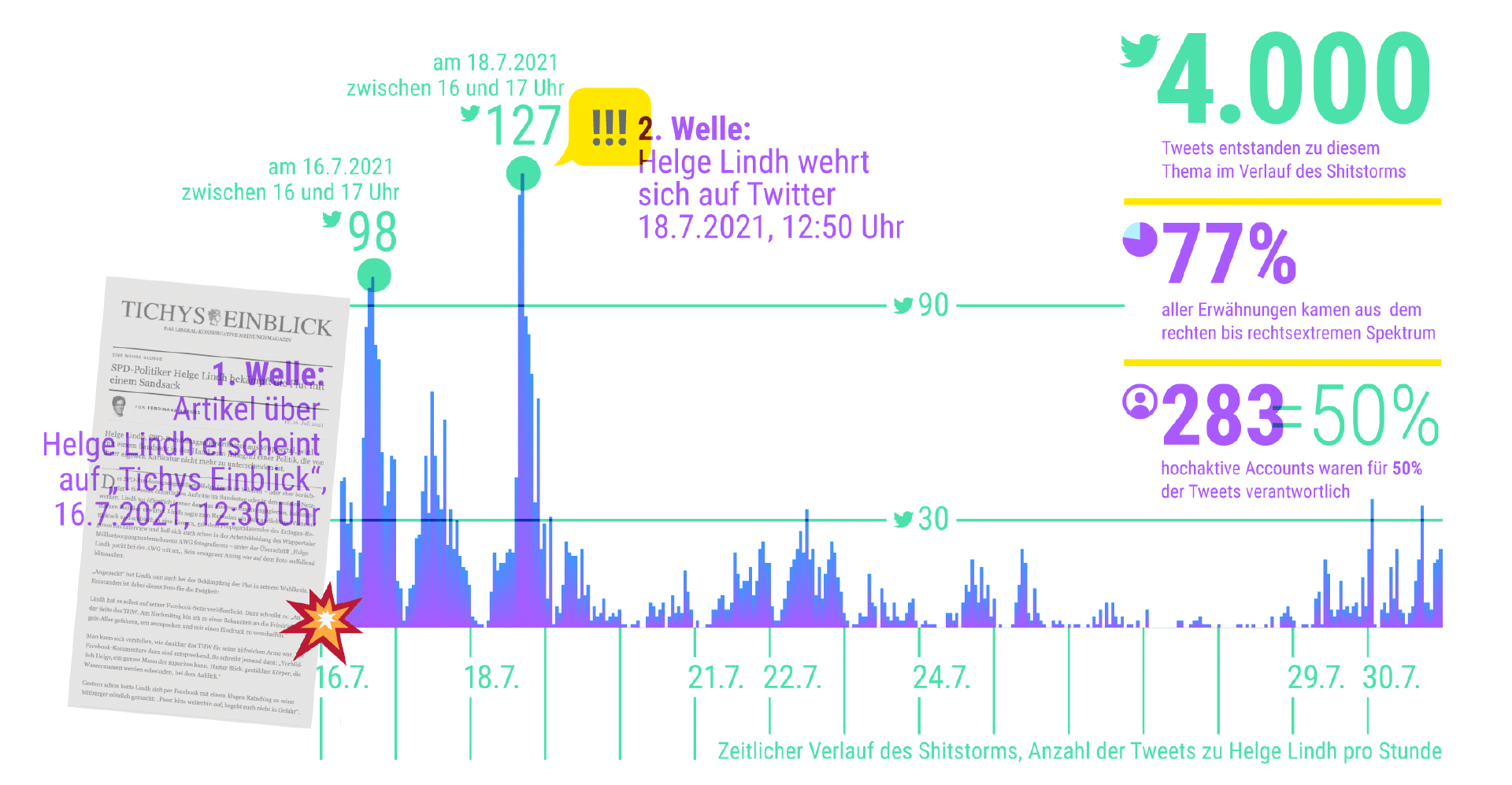People experience digital violence every day. There are many different forms and phenomena in which hate is spread online. But there are also many ways to defend yourself against it. On this page, you can find out what digital violence is, what forms it takes, how you can defend yourself and everything else you need to know about the topic.
Definition and dangers
What is digital violence?
The term digital violence refers to various forms of harassment, degradation, discrimination or social isolation on the internet or by electronic means of communication. The locations of digital violence are diverse: social networks, messenger apps, chat rooms, gaming platforms or the email inbox are just some of them.
Analogue and digital violence
Digital violence is often linked to analogue violence. Sometimes analogue violence spills over into the digital space. For example, when anti-Semitic attitudes towards Jews are not only spread at the proverbial regulars’ table, but also reach an audience of millions on social media platforms.
In other cases, digital violence becomes an analogue danger: threats that initially land in your email inbox can quickly lead to harassment and physical attacks on your own doorstep. Whether online or on the streets, violent attacks trigger fear, shame or anger in many of those affected. Unlike analogue violence, digital violence often happens around the clock in front of a huge audience. Perpetrators can act anonymously and plan targeted attacks.
Online hate concerns us all
Digital violence is a threat to us as a society as a whole. This is because online hate reinforces social discrimination and oppression by strategically ousting some people and opinions from platforms. The German government is currently discussing a new law against digital violence, which aims to strengthen human rights in the digital space.
This is important because the internet is also an opportunity to strengthen participation and democracy: People can network more easily. Access to knowledge and networks is low-threshold, which strengthens participation and global activism. To ensure fair and good social coexistence, the internet must be safe for everyone and free from violence.
Forms and phenomena of digital violence
How different digital violence looks
Whether threats by email, unauthorised publication of personal data or the spread of fake news: digital violence can look very different. We list the different forms and phenomena here.
Image-based violence
Protect yourself from image-based violence!
The misuse of image or video material is a phenomenon of digital violence that is already widespread and is constantly evolving. The term “image-based digital violence” covers various forms of abusive distribution, use or procurement of other people’s image material with the help of digital technologies.
More and more people, especially women, are experiencing image-based violence: nude photos are published without authorisation, so-called revenge porn featuring their face appears online or they receive unsolicited dickpics.


Cyberbullying
Bullying on the Internet
Bullying, insulting, exposing, belittling: Bullying no longer only takes place in analogue places such as the office or school. Cyberbullying includes various actions that are intended to put down, hurt and ostracise those affected over a longer period of time.
Insults, threats, bullying, harassment, exposure or the publication of images and video material are all part of this behaviour. When perpetrators attack victims in digital media over a longer period of time, for example in messenger chats, on social media or gaming platforms, this is cyberbullying.
Deepfakes
Deepfakes and their dangers
Fake video or audio files are increasingly circulating in the digital space. This can be funny, until suddenly fake words are put into the mouths of politicians or political telephone conversations are faked using imitation voices.
Deepfakes, from the English deep learning and fake, are video or audio files that are manipulated using artificial intelligence. Algorithms in programmes or apps make it possible to produce falsified moving images or sound recordings.
Among other things, perpetrators use these algorithms to place faces on other people’s bodies or create imitations of voices and add new text to them. In this way, they place victims in different contexts or put other people’s statements in their mouths.


Doxxing offence
Protect your privacy online!
If your private data is collected and published without being asked, this is data misuse and is called doxxing. It refers to the systematic collection and subsequent publication of another person’s private and personal data on the internet.
Disinformation
Debunk disinformation!
More and more disinformation and propaganda is being spread on social media platforms. Especially in times of crisis, the platforms are deliberately fed with “fake news”. The creators of fake news have very different motives: there are personal, political or even economic reasons for creating and spreading misinformation and false information.
Depending on who spreads the fake news on which platform, hundreds of thousands of people are quickly reached – which can have dangerous consequences.


Face Swap Apps
Face Swap Apps – When the fun stops
Face swap apps allow users to falsify audio and video files with their smartphone. Artificial intelligence makes it possible to put faces in other people’s photos or videos using programmes or apps. These fake photos or videos are called deepfakes. With face swap apps, there is now a deepfake technology suitable for mass use.
Hate speech
Stand up against hate speech!
Hate speech is a generic term for group-related misanthropy expressed verbally or in writing. This includes racism, sexism and anti-Semitism. Hate speech includes insults, calls for violence, threats and other statements, regardless of whether they are punishable by law or not.
However, the term hate speech is not clearly defined and is sometimes also used to refer to generalised hate on the internet.


Phishing
Recognise phishing attacks!
Have you ever received an email with an urgent request to click on a cryptic link and enter your details? Data theft through digital means of communication is called phishing and is one of the most common methods of cybercrime.
Romance scam
Fraud on dating apps
Online dating is now commonplace. But unfortunately, scammers with fake profiles are no longer a rarity. Such fraudulent acquaintances are often initiated via private messages.
The so-called romance scammers use publicly available information from those affected and write to them specifically. With their scams, they manage to deceive people in order to ultimately steal from them.


Shitstorm
Watch out, it’s raining hate
A hail of comments consisting of criticism, hate, insults and threats: This is what the term “shitstorm” means. A shitstorm, also known as a hatestorm, is a large amount of criticism, including hate, insults or threats, in a short period of time. A shitstorm is often triggered by a current event.
Those affected should remain calm and react calmly. Not all comments need to be answered. Discussions are often pointless because the posts often only serve to fuel the shitstorm instead of actually criticising it.
What to do about digital violence
Digital violence: what to do about it
If you are affected by digital violence yourself or would like to support others who experience online hate, you can find useful tips and contact points here.
As part of our victim counselling service, we support you with all forms of digital violence. If you are afraid and worried, our counsellors will help you.
You can always contact us via the reporting form and by email at beratung@hateaid.org. We will contact you back as soon as possible.
We also refer you to specialised and target group-specific advice centres.
Police of your country
In Germany 110
Telephone counselling service in Germany:
0800 – 111 0111
0800 – 1110 222
116 123
What does the law say?
Taking legal action against hate online
Many people think that the internet is a legal vacuum. But that’s not true. Laws also apply in the digital space. This also means that people can and may defend themselves against digital violence. Among other things, insults, threats, blackmail or incitement to hatred can be punishable online. Sending unsolicited dickpics can also be a criminal offence and can be reported to the police.
There are various ways to defend yourself against online offences. You can take action under criminal and civil law. In some cases, HateAid supports the legal process in Germany by litigation financing.
Digital violence on social media platforms
Reporting options and rules on social media platforms
Social networks are obliged by the Network Enforcement Act to delete illegal content, among other things. To do this, you report it to the respective platform using the NetzDG report form. The platforms then check the reported content.
Don’t worry: no one is liable to prosecution if something is reported that subsequently turns out not to be illegal. When completing the form, you must select a section of the Criminal Code that the content violates. If you are unsure what is behind which paragraph, it is best to look it up in a search engine. If you are unsure, you can also contact us. We have linked the individual reporting options for you here:
Each platform has its own community standards. They are not bound by our law, but they define what behaviour the networks want from their users and what content they do not tolerate. Social networks do not always delete all content that violates their community guidelines on their own. You can therefore report comments and posts directly if they violate the community guidelines. To do this, you first need to know what the respective guidelines are and how to report content:
Strengthening human rights online
HateAid is committed to a better internet. We rely on donations for this work. If you would also like to support victims of digital violence, please visit our donation page.



